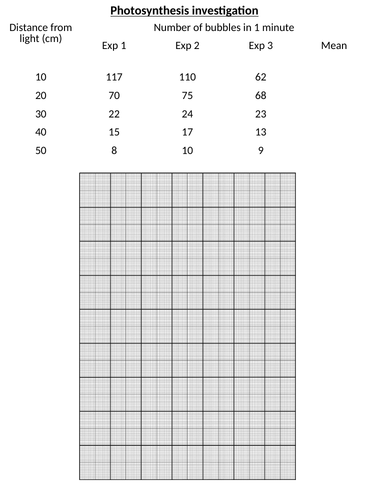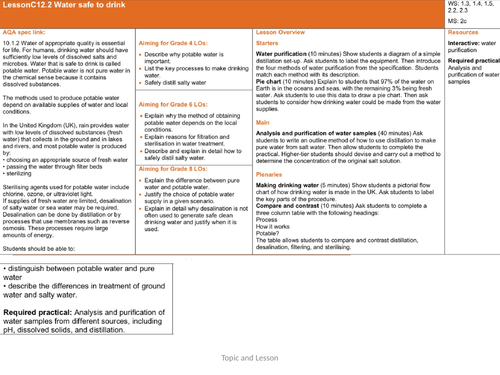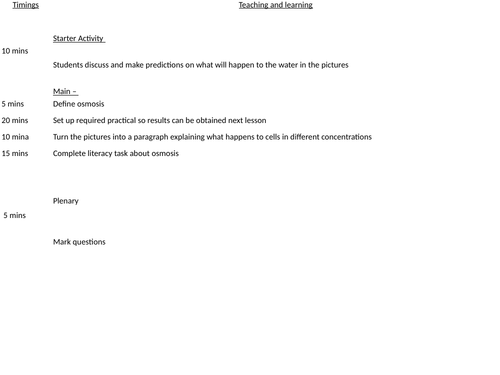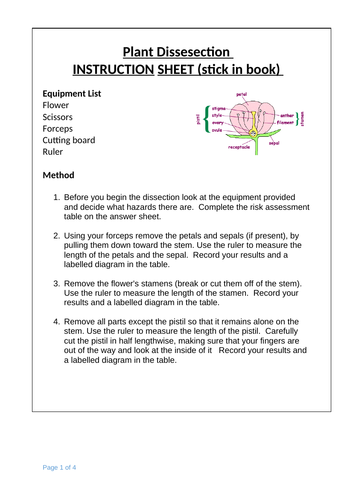
123Uploads
29k+Views
8k+Downloads
All resources

B16.1 feeding relationships
Aimed at low ability KS4 students, targets of level 3/4
Starter: Differentiated synoptic questions linking to B8 photosynthesis.
Main: match up key words, then link key words to food chain.
differentiated 6 mark question.
Broken down 6 mark question to build confidence, focusing on key words. Bronze/silver supportive sheets Gold students just answer the question.
Plenary: Mark scheme on powerpoint for students to mark and improve their answer.

Photosynthesis KS3
Starter: Recap of a plant cell.
Main - intro to photosynthesis, defintion and explaination
Video with questions to answer
Student task to explain photosynthesis with a clear success criteria given
Discuss how we can measure the rate of photosythesis
Pondweed practical could be done at this point, alternatively there is a online simulation attached.
Give students data, work out the mean, plot a graph write an evaluation. Work sheet for support given with results table and graph.
plenary - recap questions from earlier in the topic

Physics paper 1 revision
Complete paper one Physics revision following the AQA trilogy specification.
Parts for higher only are highlighted.
work booklets to accompany powerpoint, which can be used in lessons or revision sessions.
Questions embedded in the powerpoint with answers for students to practice and focus on key concepts
My year 11s have found these benefical.

Chemistry paper one revision
Complete paper one Chemistry revision following the AQA trilogy specification.
Parts for higher only are highlighted.
work booklets to accompany powerpoint, which can be used in lessons or revision sessions.
Questions embedded in the powerpoint with answers for students to practice and focus on key concepts
My year 11s have found these benefical.

B1.9 active transport
Aimed at a mixed ability year 9 class
Starter: what would happen to the particles thinking about diffusions
Main: introduce active transport, define active transport. show where it works in plants and animal cells
complete differentiated literacy activity
Extension task
Plenary: mark work, tweet one thing they have learnt today

B1.10 exchange materials
Aimed at a mixed ability year 9 class
Starter: reflect on previous diffusion practical
Main: explain surface area:vol, do practic equestions and mark
do research task to explain how surfaces are specialised
extension: checkpoint follow ups from kerboodle
Plenary" tweet what theyve learnt

C1.4 fractional distillation and paper chromatography
aimed at a mixed ability year 9 class
Starter Activity
Match key words to definitions – go through answers
Main –
Students watch demo of fractional distillation. Explain uses/whats happening at each point. Students the write an explaination of how they can obtain pure ethanol
Set up chromatography experiment, whilst waiting for it to develop write a step by step method for the practical. Go over basics, this will be revisited as chromatography is a required practical.
Plenary
Tweet one thing they have learnt today

C1.1 History of the atom
Aimed at a mixed ability year 9 class
Starter Activity
Draw and label the atom – discuss that its changed over time
Main –
Watch video of history of the atom – try and list the scientists and their discoveries
Use textbooks or ipads to research the history of the atom and fill in the timeline. Differentiated version, blank version for HA students and LA version with question prompts
Extension fill in the gaps sheet
Plenary
Draw the current atom from memory and label it

C12.1 Making water safe to drink
Starter: differentiated starter questions with answers
Main: Discussion which water from the pictures would you rather drink.
Define: potable water
Carry out required practical
answer questions
green pen, self assess questions
discuss why water is so important.
Complete worksheet to show how potable water is made (differentiated worksheets)

B1.6 Diffusion
Aimed at a mixed ability year 9 class
Starter: how do sharks find their prey easily
define diffusion
Main:: three practicals
affect of temperature
affect of concentration
affect of surface area
accompanying work sheet to fill in whilst completing practical
THen complete differentiated diffusion literacy task
Plenary: tweet what they have learnt today

B1.7 Osmosis
Aimed at a mixed ability year 9 class
Starter: Discuss and make a prediction about where the water willl move
bring it together with a definitoin of osmosis
Main: Set up practical so results can be looked at next lesson - method on slide
go through what happens to cells in different concentrations
differentiated literacy task
Plenary: mark questions

B1.8 Osmosis in plants
Aimed at a mixed ability year 9 class
Starter: what is the role of a vacuole
stretch: what happens to a plant cell if placed in concentrated sugar solution
Main: Complete required practical, record results, compelte worksheet
extension exam question if do complete
Plenary: mark required practical

B2.3 stem cells
aimed at a mixed ability year 9 class - worksheet from tes
Starter
What is a stem cell. Turn the picture into words – looking for key words, undifferentiated, differentiated
Main –
Watch a video, explaining what stem cells are and what they can be used for
Research task, differentiated criteria to find out about stem cells use p.30-31 in kerboodle text books, ipads
extension: worksheet with questions
Plenary
Peer assess each others work, which level do they think their partner has achieved, using the success criteria

B2.2 Growth and division
Aimed at a mixed ability year 9 class
Could do the practical - but where it falls with teaching my class this im unable to, task to use the method instead
Starter: Students discuss how cells change through the life time of a human
Go through what happens at each stage in life, students then write their own description in their books of what happens at each stage
Stretch: if cells are repaired and replaced and there are stem cells how are people paralysed
Main –
Discuss how plants grow – key words on the board, from discussion get students to write their own definitons for these words, green pen their answers
Turn method for how to clone cauliflower into a storyboard – alternatively you can carry out the practical.
Extension questions if students finish task
Plenary
Explain why a starfish is more like a plant than an animal in terms of its ability to regrow limbs

C1.2 Separating mixtures
Aimed at a mixed ability year 9 class
starter:
Differentiated starter task from previous learning. Bronze = level 4 silver – level 6 gold = level 8 (to be gaining a level 8 answer needs to be really detailed) students have done this at KS3
Go through and green pen answers
Main
Talk about safety for the practical, demo practical with distillation to get pure water
Students carry out rock salt practical to get salt
Answer questions when done, extension question available also
Plenary
5 mins
Identify the three processes we have learnt about today
Homework - differentiated
Summary sheet on separation techniques

C1. 8 electronic structures
Aimed at a mixed ability year 9 class
Starter Activity
Exam question starter – go through and green pen
Main –
Recap where to find the number of electrons an atom has, go through electronic structure rules. Do a few examples on the board
Two worksheets – first worksheet students need to find out the number of protons, neutrons and electrons each element has, the second they need to draw the electronic structures
Extension: explain why sodium and lithium might react in a similar way
Write a step by step guide for somebody to explain how you draw electronic structures
Plenary
Exam question plenary – spot mistakes in the electronic structures

Structure of a plant
Aimed at KS3 students.
This lesson recaps KS2 prior knowledge on the structure of a plant. Before moving onto KS3 content about structure and function of parts of the plant, followed by a plant dissection, accompanied by worksheets.

KS3 Respiratory system and gas exchange
Starter: Simple recall questions based on prior knowledge, easily changed to suit your class
Main:
Information about the respiratory system, then a labelling task, a putting in order task and questions to consolidate learning. All answers on the powerpoint.
Gas exchange information on the ppt also a drawing of how it can be taught under the visulisar, followed by questions to check understaning.
Plenary
True or false

Photosynthesis and use of glucose
Starter Activity
No goal retrieval starter. Students given a picture of the structure of the leaf and annotate what they can remember.
Go through answers, students annotate anything they did not already know.
Main –
Students listen whilst teacher explains what photosynthesis is (5minutes)
Students answer task 1 and task 2 – write the equation and describe the process of photosynthesis (10 minutes) Success criteria can be given to LA students for support
Go through answers, success criteria on the board, question students for answers, green pen answers (5 minutes)
Students think of the answer to the questions on the board whilst demonstrate the testing for starch test.
Students move around the room to find ways plants use glucose
Plenary
Differentiated exam questions




















